Image by fizkes on Shutterstock
Writing a great resume is all about understanding what goes into it. This includes knowing how to write it, what to include, and what recruiters expect from you.
Every industry has different expectations when it comes to resumes. Where you are in your career also affects how you should format your resume. For example, if you have fewer than 10 years of experience, your resume should not exceed one page. And while applicants with more than 10 years of experience can use two pages, many still use only one.
To help you get a better idea of what recruiters are looking for today, here are 10 key resume statistics you need to know. Let’s get right into it.
1. 98.8% of Fortune 500 companies use an applicant tracking system (ATS) to evaluate resumes (Source)
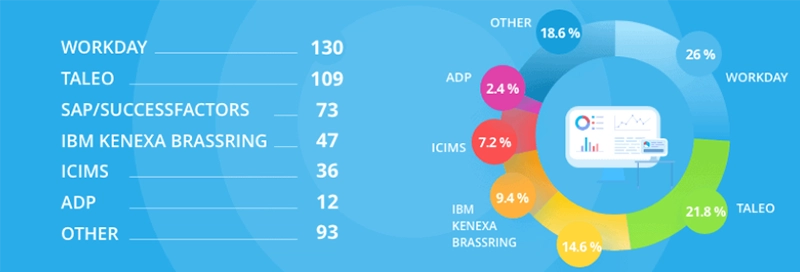
Among Fortune 500 companies, 494 use an ATS to manage their influx of resumes. Of those, 130 use Workday and 109 use Taleo as their ATS. Other prominent ATSs include SAP, IBM Kenexa BrassRing, iCIMS, and ADP.
Applicant tracking systems look for specific keywords in a resume to determine whether it’s relevant for the job opening. The purpose of an ATS is to minimize the number of resumes that are filed incorrectly. For example, if someone uploads a resume for the wrong job, or intentionally applies for a job that’s irrelevant to their skills and experience, the resume will be forwarded accordingly.
Some companies use the ATS to weed out candidates who paid attention to the job description and those who didn’t.
It’s crucial to optimize each resume for applicant tracking systems. The best way is to read the job post thoroughly and identify important keywords. Then, use those keywords in natural, organic ways throughout your resume, like when mentioning prior achievements, skills, or other qualifications.
Since most organizations use an ATS, you should never submit a resume as a PDF or other image-based format. Always use a text-based format like Google Docs, Microsoft Word, or other software so your resume can be scanned and filed by artificial intelligence.
Optimizing for the ATS is important for everyone, from college students to professionals with decades of experience. But don’t keyword-stuff your resume—that is, fill it with irrelevant or overused keywords. Your resume has to be written for human audiences as well as AI. While keyword-stuffing might get you past an automated system, a recruiter or hiring manager will see right through this trick and it won’t help you in the long run.
2. The average length of a resume is 489 words while the median resume length is 369 words (Source)
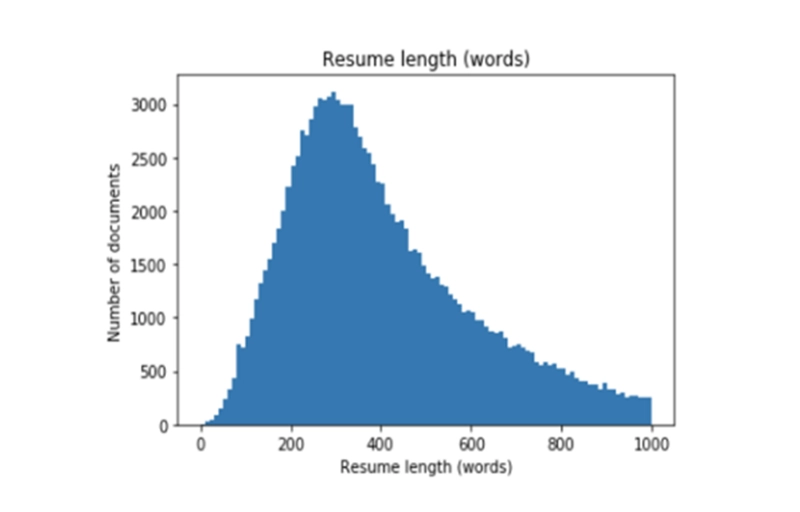
While you don’t need to adhere strictly to these numbers while writing your resume, aim to fall within a reasonable distance of them.
One resume page takes up about 380 words, and since data shows most applicants stick to that it’s also what recruiters will be expecting. However, if you have more than 10 years of experience, it’s fine to use two pages, which doubles the amount of words you have to make your case.
You should always use bullet points rather than paragraphs when providing information. A one-page resume should have 10-15 bullets, and a two-page resume can have up to 25.
Long paragraphs lead to missed opportunities because recruiters don’t spend a lot of time going through resumes. In fact, your resume will have an average of 7.4 seconds to impress the recruiter before they move on to the next resume.
To progress in the hiring process, you have to make a good first impression. That means crafting a short resume with simple formatting and concise information, so it’s easy to skim and digest.
3. 85% of recruiters believe that candidates exaggerate their skills on their resumes (Source)
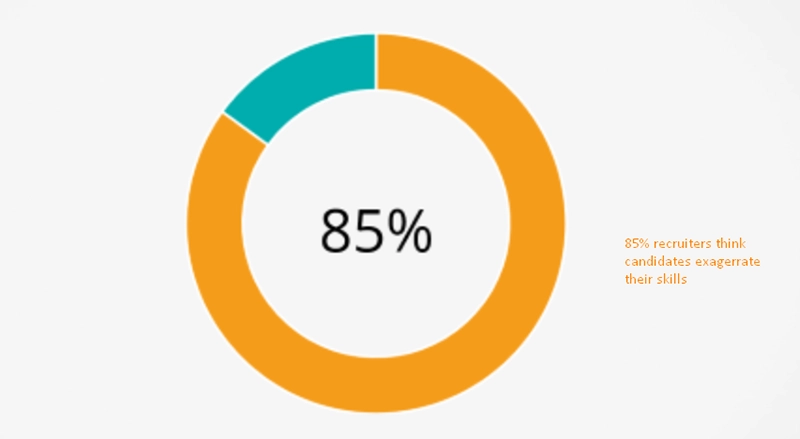
According to the same survey, only one-third of the recruiters polled felt that their candidates were “very honest” about their skills and proficiencies.
Interestingly, millennial recruiters tended to be more trusting of candidates to the point where 41% believed candidates are “very honest.”
However, 88% of millennial recruiters still agree that candidates may exaggerate skill competencies, compared to 83% of Gen X recruiters.
Honesty and transparency are issues on both sides, not just the side of the candidates.
35% of recruiters acknowledge that candidates going through their hiring process aren’t happy when they aren’t given any indication of why they weren’t chosen for the next stage.
The study also found that 37% of North American recruiters believe that following up with candidates in a timely manner contributes to candidate happiness, compared to 31% of European recruiters.
4. 65% of hiring managers and recruiters have caught candidates misrepresenting information on their resume (Source)

This includes 45% of candidates misrepresenting technical skills, 44% exaggerating work experience, 37% lying about salary history, and 36% misrepresenting their educational history.
Here are other things candidates are likely to misrepresent:
- Citizenship status: 27%
- GPA: 26%
- References: 26%
- Competitive offers: 24%
- Tenure for prior positions: 22%
- Criminal history: 21%
- Language proficiency: 20%
Recruiters expect authenticity and trustworthiness from candidates. Misrepresenting information may get candidates past the ATS and even help them land an interview, but they should expect the truth to come out. And when it does, it will not be good for them.
If a candidate misrepresenting themselves does manage to get hired, it can be worse for them in the long run, as discovery can be grounds for immediate termination and even a lawsuit in some situations.
Always double-check the information you provide in your resume, especially job titles, names of companies, names of degrees and academic certifications, and work tenure. It’s likely that someone in the hiring process will notice any discrepancies, and you don’t want an honest mistake to hurt your credibility.
5. Previous job experience is a top decision-making priority for 56% of recruiters aged 19-29, but it matters more (81%) for recruiters aged 50-64 (Source)
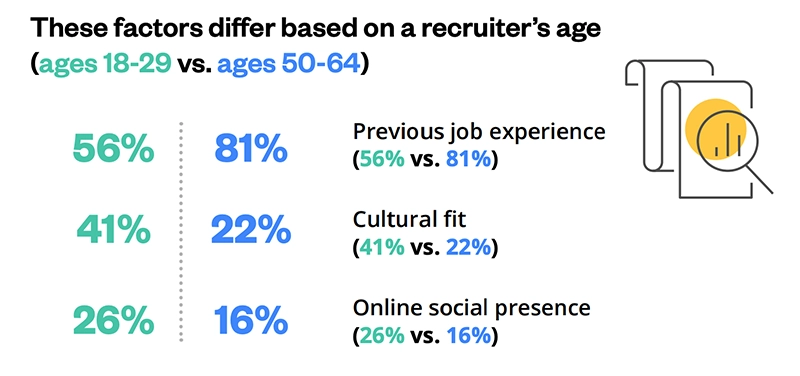
The age of the recruiter affects what matters most when reviewing resumes. Older recruiters put far more weight on previous job experience than younger recruiters when assessing a candidate, but a significant percentage of recruiters of all ages cited it as a deciding factor.
There are also differences in how younger and older recruiters weigh cultural fit and online social presence. Among recruiters aged 18-19, cultural fit is much more important than it is among recruiters aged 50-64. Of those polled, 41% of younger recruiters cited it as a decision-making factor but roughly half of older recruiters (22%) agreed.
Online social presence is also much more important among younger recruiters than it is for older recruiters. It was cited as a major deciding factor by 26% of recruiters aged 18-29, but only 16% of recruiters aged 50-64 reported taking it into serious consideration.
When writing your resume, be sure to include all relevant job experience to improve your chances of catching the eye of a recruiter. While your resume may give recruiters some idea of your cultural fit, this likely will be better conveyed through conversations with your recruiter prior to job interviews. In almost all cases, social media presence will be irrelevant to mention on your resume, but it is something you should expect recruiters to research on their own when making a decision.
6. For 79% of hiring managers, spelling and grammatical errors are resume deal-breakers (Source)
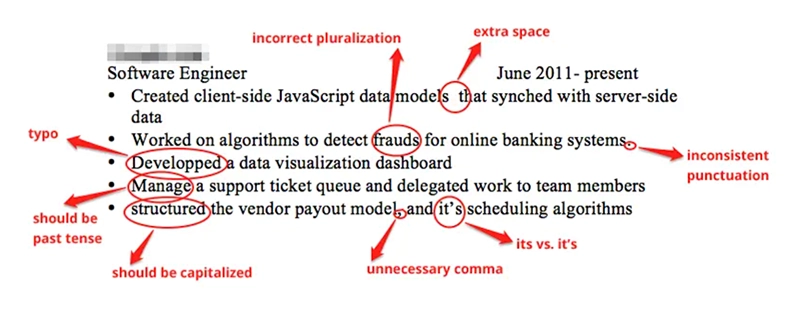
Meanwhile, 52% of hiring managers consider missing or incorrect contact information to be a deal-breaker.
Other common issues in resumes include:
- Unprofessional personal email address: 46%
- Irrelevant information (marital status, age, interests, hobbies, etc.): 45%
- Unquantifiable results: 33%
- Keyword-stuffing and unnecessary buzzwords: 32%
- Generalized resume (not customized): 32%
- Repetitive phrases and words: 28%
- Picture or headshot: 28%
- Fancy design or format: 28%
While those are the issues that concern recruiters, the study also found five top reasons job seekers get stressed about their resumes:
- Whether they’ve used the right keywords to ensure their resume passes: 68%
- Ability to showcase value to the recruiter: 53%
- Writing a good professional summary: 47%
- Ensuring the right kind and amount of information is in the resume: 40%
- Editing and tailoring the resume for each job: 37%
It’s a good idea to make a list of such potential issues when crafting your resume and cross them off as you’re confident you’ve resolved them. And always double-check your resume for typos before submitting.
7. 61% of recruiters believe that soft skills are just as important as hard skills on a resume (Source)
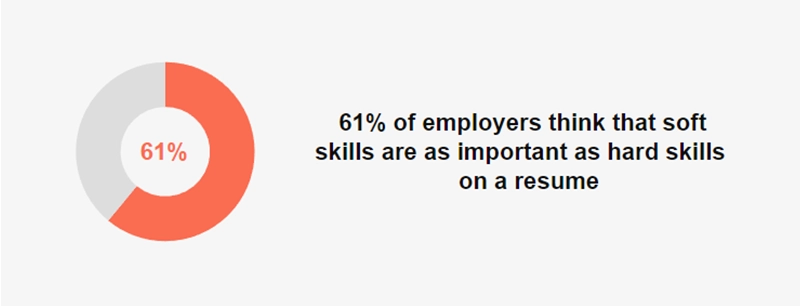
Listing your work experience can help show recruiters you have the hard skills necessary for the job, but it gets trickier when you’re looking to validate your soft skills. These include skills like:
- Analytical thinking
- Negotiation
- Decision-making
- Team-building
- Communication
- Creativity
- Conflict resolution
- Public speaking and leadership
- Empathetic listening
- Being detail-oriented
- Prioritization
- Adaptability
Including soft skills on your resume helps hiring managers understand your characteristics and suitability for the job. They understand how the company culture works, what the current work-life balance looks like, and how engaged the average employee is.
The soft skills you possess can also point to what kind of future you may have if you get the job, such as your chances for promotion, lateral movement, and ability to establish long-term relationships.
8. From 2017 to 2021, the importance of online education and certificates in resumes increased from 8% to 39%, as did resume format from 17% to 36% (Source)
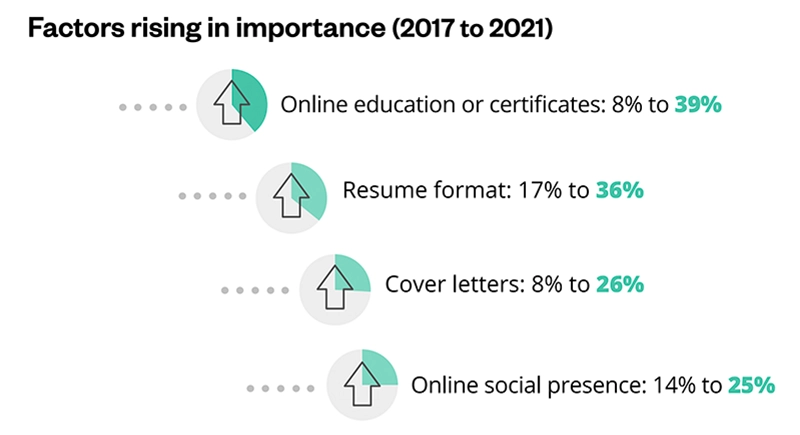
Other factors that increased in importance include:
- Resume format: Increased from 17% to 36%
- Cover letters: Increased from 8% to 26%
- Online social presence: Increased from 14% to 25%
And these factors decreased in importance:
- Employee referral: Decreased from 51% to 31%
- Cultural fit: Decreased from 83% to 28%
- Previous job experience: Decreased from 92% to 62%
Recruiter priorities are in constant flux due to a number of reasons. The primary reason is the company and its culture. However, other important factors include the industry, how old a company is, who the top-level executives are, and what values are important to the company.
These factors directly affect hiring practices, which is why two seemingly similar companies in the same industry can have vastly different recruitment processes.
9. 99.85% of all resumes include a personal information section, 98.33% have a work experience section, and 97.25% have an education section (Source)
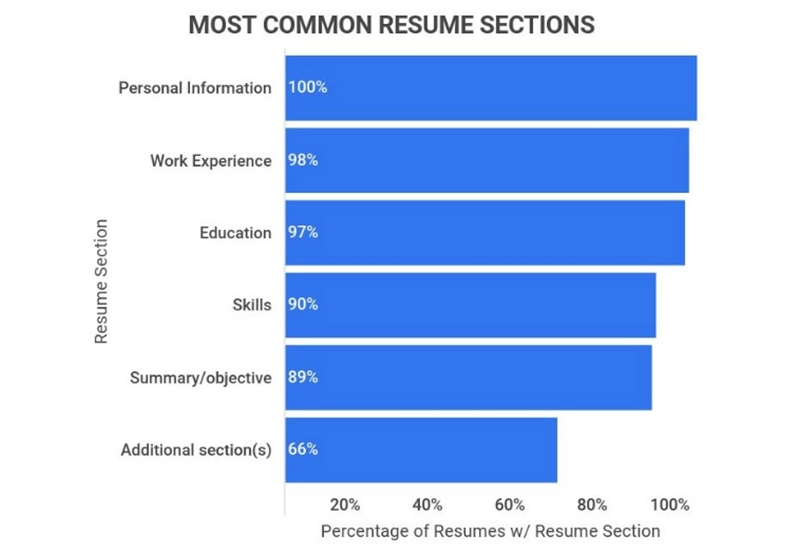
A skills section (and including the right skills) is also essential, and it’s present in 89.81% of resumes. However, while 88.75% of resumes include a summary or objective, it’s important to include a summary rather than an objective, as an objective is not the most effective way to convey your intent to your (screener, recruiter, future boss, ATS).
Instead of writing an objective, write a professional summary that includes 12-16 powerful, concise phrases over three to four lines.
The professional summary begins with a professional headline in bold and all caps. It’s your primary marketing pitch and should include your next job title with a slightly flattering adjective.
Here’s an example of a professional summary with a professional headline:

- Always ensure you include these must-have resume sections:
- Contact information
- Professional summary
- Work experience
- Education
- Skills and proficiencies
Be as brief as possible while covering all relevant information. This can be especially challenging if you’re a professional with fewer than 10 years of experience, as your resume should be limited to one page. You can use two pages if you’ve been in your career for more than a decade, but a succinct, one-page summary can still be ideal.
When writing your work experience section, use 10-15 bullet points if you’re using a one-page resume. You can use up to 25 bullet points if your resume is two pages. The purpose of these bullet points is not to rattle off all the great things you’ve accomplished in your career, but to show recruiters what you can accomplish for your next employer. So for each point, use a success verb and numerical value, such as “Improved project turn around by 23%.”
You can find more tips on writing strong, quantifiable bullet points here.
10. Applicants with a comprehensive LinkedIn profile have a 71% higher chance of landing an interview (Source)
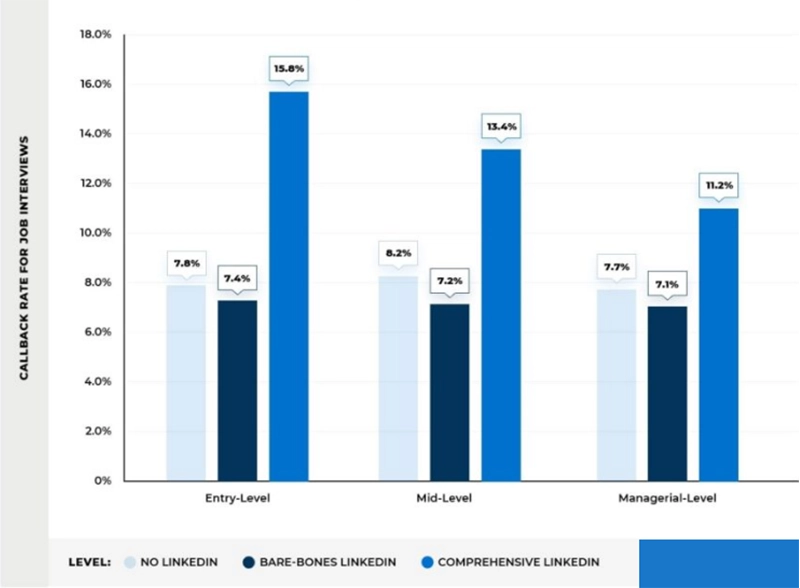
Having a LinkedIn profile can help you get a callback, but only if you’ve put significant effort into. A bare-bones LinkedIn profile can actually hurt your chances of hearing from a potential employer, with a 9% decrease in the interview callback rate.
However, the impact of having a LinkedIn profile decreases as the job level increases.
For entry-level jobs, applicants without a LinkedIn profile have a 7.8% callback rate, a 7.4% callback rate with a bare-bones profile, and a 15.8% callback rate with a comprehensive profile.
If you’re applying for a mid-level position, you have an 8.2% chance of getting a callback if you have no LinkedIn profile, a 7.2% chance if it’s bare-bones, and a 13.4% chance if it’s comprehensive.
For managerial-level jobs, your call back rate decreases to 7.7% if you have no LinkedIn profile, stays relatively the same if you have a bare-bones profile at 7.1%, but the importance of having a comprehensive profile diminishes, as it only leads to a 11.2% callback rate.
While there may be a question of causation vs. correlation here, putting together a comprehensive LinkedIn profile gives potential employers important information about you as a candidate and helps them in the decision-making process. Likewise, a bare-bones LinkedIn profile may point to a lack of effort or attention to detail.
Even if you have a strong resume, a poorly developed LinkedIn profile, or no profile at all, can raise doubts.
No matter the level of the job you’re applying for, don’t neglect LinkedIn. You can also upload your resume to LinkedIn to increase the chances of a recruiter noticing you.







